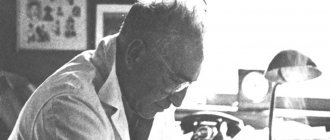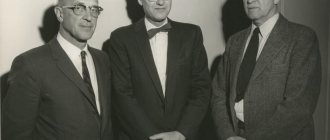Childhood and youth
Alfred Adler was one of seven children in the family of a Jewish grain merchant and his wife. As a child, he suffered from rickets and was unable to walk until he was four years old. At the age of five, he was seriously ill with pneumonia. All his childhood illnesses influenced his decision to become a doctor.
Alfred Adler received his primary education at a classical high school. He then entered the Faculty of Medicine at the University of Vienna, graduating in 1895. During his studies, he began to communicate closely with a group of socialists.
1870-1888 - difficult childhood
On February 7, 1870, a third son was born in a Jewish home on the outskirts of Vienna. Three more will appear in the future. The area of Vienna where the Adlers lived did not have a dense Jewish agglomeration. Therefore, from childhood, the boy practically did not feel like a Jew, but rather a crown. This element of freedom manifested itself in the future in an indifferent attitude towards the ideas of anti-Semitism and Judaism. At one time he was even a Protestant: meet Alfred Adler!
In 1872, two-year-old Alfred would have a younger brother. This is a serious childhood trauma. The roots of which Adler later explores in his scientific works, identifying it as a question of birth order. So until the baby arrives, Alfred is his mother's favorite. Now this role has been taken by the newborn, and he has become his father's favorite. A year later, the younger brother died, lying in the same bed with three-year-old Alfred. But the wave of maternal tenderness will not return to him. But my father’s remained and only intensified. It is thanks to his father that Adler owes his academic success. In the elementary grades, due to poor health, little Alfred is characterized by total academic failure - a repeater. The director recommended that the parents take their son out of school, and, if they are lucky, the boy will be taken on as an apprentice by a shoemaker. But the father showed unprecedented pedagogical persistence in teaching his son. Result: for the next school year Alfred is the first in mathematics success.
Career
At the beginning of his career, Adler practiced ophthalmology, but then switched to therapy. From childhood he was interested in socialism, and even wrote articles for socialist newspapers. In 1902, Adler received an invitation from the famous psychiatrist Sigmund Freud to join the “Wednesday Psychological Club,” whose members studied various aspects of psychoanalysis.
In 1910, Adler became president of the Vienna Psychoanalytic Society, but by this time differences with Freud's views were growing, and Adler left the society a year later.
In 1912, Adler founded the Society for Individual Psychology. And although he left Freud's company due to differences in views and thoughts, Adler and Freud respected each other and drew inspiration from each other's work. In 1913, Adler called his teaching a system of individual psychology.
During the First World War (1914-1918) he served for three years in hospital support. After the end of the war, he founded a consultation clinic for children with severe mental illness in Vienna. He also proposed introducing in schools the position of a person responsible for working with mentally unstable children.
In 1924, he accepted the invitation and took up a teaching position at the Pedagogical Institute in Vienna. He often traveled and made presentations in many educational institutions in Europe and America. In 1927 he became a visiting professor at Columbia University.
In 1932, after Hitler's party came to power in Austria, Adler moved to New York, where he took up a professorship at Long Island Medical College. Until the end of his days, he traveled around the world with his lectures.
Alfred Adler was a very prolific author, writing more than 300 books and articles during his life. His most significant works: “The Practice and Theory of Individual Psychology” (1927), “Comprehension of Human Nature” (1927), “The Meaning of Life” (1931).
Striving for superiority and feelings of inferiority
Adler’s concept is based on the idea of a single driving force that underlies the structure of the personality and directs all its resources to achieve the most important goal, which gives meaning to the entire being of the individual. Such a goal, according to Adler, is the desire for superiority or self-affirmation.
The desire for superiority (self-affirmation) is the desire to overcome one’s own shortcomings and realize one’s fullest potential.
It is this goal that subordinates the entire movement towards more complete development and fulfillment, the realization of our Self. Adler was convinced that this desire for superiority is an innate factor, its traces can be easily detected in all aspects of personality manifestation.
The true driving force of personality is a generalized feeling of inferiority. A feeling of inferiority is a human experience associated with a feeling of being inferior and of little value; associated with organic and functional inferiority of a person.
Strong feelings of inferiority, or inferiority complex, can make positive growth and development difficult. However, a moderate feeling of inferiority encourages the child to grow, to become as strong or even stronger than others, to strive for improvement, for superiority, for the development of his abilities. Those. the desire to overcome the inferiority complex starts the process of human development.
Initially, Adler attributed this feeling of inferiority to bodily defects. A child with hereditary organic defects will try to compensate for them through more intensive development of the defective function. For example, a child who stutters with the help of speech therapy can become a great speaker, a child with weak limbs after intense physical exercise becomes a good athlete or dancer.
Adler later expanded the concept of inferiority to include all types of physical, mental or social defects - real or imagined. He also believed that the weakness and helplessness of a child, his dependence on the environment leads to the emergence of a feeling of inferiority, so familiar to every person. The child is aware of his inferiority and the need to overcome the disadvantage, but at the same time he is driven by an innate desire for superiority. As a result, such a process moves the individual towards greater perfection and realization.
Main works
He founded Adler's Association for Individual Psychology, which was originally called the Society for Free Psychoanalytic Research. His work was dominated by a holistic approach to the study of human psychology and personality. He identified several fictitious goals, which are mostly unconscious. Adler was convinced that human psychology was psychodynamic and could be explained telelogically. He also believed that the conscious and unconscious worked in tandem to achieve fictitious goals. Adler believed that the inferiority complex has an extremely strong influence on determining the development of a person’s personality. He also thought that inferiority complex was a major factor in behavior problems in children.
Adler's Individual Theory of Personality
Alfred Adler's psychological views were formed under the influence of his entire life, filled with a fierce struggle for existence. He overcame his illnesses, weaknesses, fears and achieved enormous success in life. Having been almost a complete vegetable since childhood, he gradually turned into a superman.
Classic Freudian psychoanalysis based human behavior on the unconscious. Freud considered libido – sexual desire – to be the engine of personality development. Alfred Adler did not agree with this and put forward a theory according to which consciousness plays a dominant role in the development of personality. Human behavior, according to his theory, is guided not by biological, but by social motives. Every person has an innate social sense, which, however, needs to be nurtured and developed so that it can be realized.
Adler's theory assigned a certain place to the subconscious. But she recognized not sexual attraction as the driving force of social development, but the thirst for power and an inferiority complex. From this complex, according to Adler, come such human vices as vanity and ambition, but virtues such as the desire for cooperation and courage also flow from it.
The inferiority complex played a significant role in the development of the personality of many great figures. Thus, the ancient Greek orator Demosthenes suffered from a speech impediment for a long time and tried with all his might to overcome it. Many great commanders were short - such as Suvorov and Napoleon (for example, evidence of Napoleon’s short stature is a legend; in reality, his height was even slightly above average). It is the feeling of inferiority that pushes many people to overcome what they consider to be shortcomings, and in this they achieve significant success.
On the other hand, many great villains and criminals also had an inferiority complex. Thus, African and Latin American dictators often came from very poor families belonging to the lowest social categories. And their whole life was a kind of attempt at revenge on everyone who was more successful socially and economically. When they came to power, these dictators began to persecute the rich, educated, successful citizens of their countries, liquidating the economy, infrastructure and social sphere.
According to Adler, from the very beginning, most children have an inferiority complex compared to “omnipotent adults.” And during their development, children try to overcome this complex.
Only some of them develop in a positive direction - they study hard, get involved in work, help with housework, etc. While others choose a negative direction: they begin to drink alcohol early, smoke, behave rudely and cynically, etc. Pathological manifestation the desire to “become an adult” may also be a thirst for power over others.
Sometimes an inferiority complex is expressed through some kind of disguise. For example, poor people try to look rich, for which they make impulsive purchases, buy expensive but absolutely useless things, and play in a casino. Disguising an inferiority complex can be cheeky behavior, drinking large amounts of alcohol, and increased aggressiveness.
Alfred Adler was the first to introduce the concept of an inferiority complex. And the first person in whom he observed both this complex and its overcoming was himself.
Individual psychology, created by Adler, gained enormous popularity in European countries and in the USA in the twenties and forties of the twentieth century - probably more popular than classical Freudianism. The teachings of Freud himself were regarded by many as too primitive and vulgar, and besides, his methods of psychoanalysis did not always work. But Adler’s theory was more in line with reality and paid much more attention to the social aspect of human life.
Adler began to put his ideas into practice by taking up pedagogy. He founded an educational clinic for children, and then an experimental school. Soon there were more and more such institutions; they began to appear not only in Austria, but also in other countries.
Adler's theory became one of the main elements of humanistic psychology that emerged in the 1950s, which aimed at the comprehensive development of the human personality. Humanistic psychology developed mainly in the United States, where it became an alternative to the then dominant behaviorism and classical Freudian psychoanalysis. Humanistic psychology recognized man as a special, higher essence and opposed equating him with animals, in whose psyche only reflexes and instincts predominate.
Personal life and legacy
While studying in Vienna, Alfred Adler met Raisa Epstein, a Russian public figure. The couple married in 1897 and had four children. His daughter Alexandra became a psychiatrist and public figure, and his daughter Valentina became a writer and public figure.
In 1937, while on a work trip to the University of Aberdeen, Scotland, Adler died unexpectedly of a heart attack at the age of 67.
In 1952, the Adler School of Professional Psychology was founded in Chicago to continue the work of the outstanding psychiatrist.
ValentinaThe Russian pages of Adler's life will be incomplete without considering the tragic fate of Valentina Adler, the eldest daughter of Alfred and Raisa. Valentina Dina Adler, according to Haag (2012), was a Marxist idealist who absorbed and carried within herself a sincere belief in socialism as a truly new and, of course, fair world order, being implemented in the USSR and leading the world to an unprecedented era of justice. The rise of Nazism could only strengthen her faith, and in 1933 she moved to Moscow, where her husband, the Hungarian communist Gulya Szasz, had already settled. Together and surrounded by equally committed colleagues, they worked tirelessly for several years, without losing faith that the Soviet Union, led by Stalin and the All-Union Communist Party of Bolsheviks, could create a stable and prosperous state, capable of not only resisting Nazism, but also protecting the world from it.
On January 19, 1937, Valentina was arrested and, a few months later, sentenced to ten years. The official charge is illegal connections with Trotskyist terrorists, Article 58 of the Criminal Code. In 1949, in the book “Under the Rule of Two Dictators: Prisoner of Stalin and Hitler,” Margarete Buber-Neumann, Valentina’s former Butyrka cellmate, recalled that Valentina was very weak and pale. According to Buber-Neumann, Valentina was treated very roughly during interrogations, forcing her to confess to personal connections with Trotsky, which she supposedly had to maintain through the mediation of her parents (Buber-Neumann, 1949, p. 135). Valentina's fate remained unknown until 1952, when, thanks to the assistance of Albert Einstein, the date of her death became known and she was posthumously rehabilitated. Valentina died in 1942.
Adler's biographers, without exception, discuss the fact that Adler died just four months after Valentina's disappearance. Although by the time of his death he was already an elderly man by the standards of that time, Adler's friends and colleagues noted that he maintained fairly good physical shape and, being an excellent diagnostician, did not complain of any serious health problems (Bottome, 1939) . Moreover, his lecture tour, which included two lectures in Paris 10 days before his death and a series of summer appearances in England and Scotland, began very successfully and was expected to evoke extremely positive emotions. British newspapers, according to the recollections of Adler's secretary Evelyn Feldman, were full of news and discussions about the visit of the famous psychiatrist (Manaster, Painter, Deutsch, & Overholt, 1977). Alexander's middle daughter, a promising neurologist, planned to join his tour. Wife Raisa was awaiting the arrival of her youngest daughter Nellie in Paris, so that she could then go to England together and meet her husband there. Many other performances and projects were planned.
There were reasons for concern, of course. Nelly's marital relationship with her husband Heinz worried both parents. Europe was on the brink of war, and the fate of individual psychology in Austria and Germany was in danger (Bottome, 1949; Cocks, 1997; Ellenberger, 1970). Nevertheless, being, according to many, an extraordinary optimist, Adler did not succumb to pessimistic sentiments. A study of his life shows that he was not just an optimist, but a practical optimist. As painful as it was to realize the onset of Nazism, Adler was able to see and welcome in the United States a new, albeit temporary, home for his theory, and in 1935 he began publishing the English-language International Journal of Individual Psychology. No matter how disturbing the news from friends and colleagues in Austria, Adler found ways to support them and help them stay motivated (Manaster, Painter, Deutsch, & Overholt, 1977).
The fate of his eldest daughter became a completely different, insurmountable, emotional test for Adler: what tormented him most of all was not so much the fact of the unknown and fear for his daughter, but, according to Bottom, the impossibility of helping her, the apparent absence of ways to establish any contact with her, a feeling of helplessness (Bottome, 1949). Adler's official medical cause of death was heart attack. Biographers of the great psychologist would most likely see his untimely death as the result of a great shock, what is commonly called broken heart syndrome.
Bibliography of Alfred Adler
Works on English language:
Adler, A. (1927). Menschenkenntnis. Leipzig. Adler, A. (1927). The neurotic constitution. New York: Moffat, Yard. Adler, A. (1928). Understanding human nature. London: Alien & Unwin. Adler, A. (1928-1930). Die Technik der Individual psychologie. München: Bergmann Adler, A. (1929). The practice and theory of individual psychology. London: Routledge & Kegan Paul. Adler, A. (1930). The science of living. London: Alien & Unwin. Adler, A. (1931). What life should mean to you. Boston: Little, Brown. Adler, A. (1956). The individual psychology of Alfred Adler: A systematic presentation in selections from his writings H.L. Ansbacher & R.R. Ansbacher, Eds.). New York: Harper & Row. Adler, A. (1964a). Problems of neurosis: A book of case-histories. New York: Harper Torchbooks. Adler, A. (1964b). Social interest: A challenge to mankind. New York: Capricorn Books. Adler, A. (1964c). Superiority and social interest: A collection of later writings (HL Ansbacher & RR Ansbacher, Eds.). New York: Viking Press. Adler, K., & Deutsch, D. (Eds.). (1959). Essays in individual psychology. New York: Grove Press. Ansbacher, H. L. (1971). Alfred Adler and humanistic psychology. Journal of Humanistic Psychology, 2, 53-63. Ansbacher, H. L. (1974). The Adlerian and Jungian schools. [Part] A: Individual psychology. In S. Arieti (Ed.), American handbook of psychiatry. New York: Basic Books. Ansbacher, H. L. (1990). Alfred Adler's influence on the three leading cofounders of humanistic psychology. Journal of Humanistic Psychology, 30, 45-53. Bottom, P. (1957). Alfred Adler: A portrait from life. New York: Vanguard Press. Carlson, J. (1995). Adlerian parent consultation. In A. Dougherty (Ed.), Case studies in human services consultation. Pacific Grove, CA: Brooks/Cole. Dreikurs, R. (1950). Fundamentals of Adlerian psychology. New York: Greenbcrg. Dreikurs, R. (1957). Psychology in the classroom: A manual for teachers. New York: Harper & Row. Dreikurs, R. (1964). Children: The challenge. New York: Dutton. Ellenberger, H. (1970). The discovery of the unconscious: The history and evolution of dynamic psychiatry. New York: Basic Books. Ellis, A. (1970). Tributes to Alfred Adler on his hundredth birthday. Journal of Individual Psychology, 26, 11-12. Essays in Individual Psychology: Contemporary Application of Alfred Adler's Theories. Ed. Adler K.A., Deutsch D.N.Y., 1959. Frankl, V. (1970). Tributes to Alfred Adler on his hundredth birthday. Journal of Individual Psychology, 26, 12. Gray, L. (1998). Alfred Adler, the forgotten prophet. Westport, CT: Praeger. Hall, C., & Lindzey, G. (1957). Theories of personality. New York: Wiley. Hoffman, E. (1994). The drive for self: Alfred Adler and the founding of individual psychology. Reading, MA: Addison-Wesley. Kawulich, W., & Curlettc, W. (1998). Life tasks and the Native American perspectives. Journal of Individual Psychology, 54, 359-367. Kern, C. (1993). Adlerian counseling. TCA Journal, 21, 85-95. Kottman, T. (1995). Partners in play: An Adlerian approach to play therapy. Alexandria, VA: American Counseling Association. Lakein, A. (1974). How to get control of your time and your life. New York: New American Library. Manaster, G. J., & Corsini, R. J. (1982). Individual psychology. Itasca, IL: F. E. Peacock. Martinex, D. (1998). Transcending cultures: the American process. Journal of Individual Psychology, 54, 346-358. Maslow, A. (1970). Tributes to Alfred Adler on his hundredth birthday. Journal of Individual Psychology, 26, 13. May, R. (1970). Tributes to Alfred Adler on his hundredth birthday. Journal of Individual Psychology, 26, 13. Mosak, H. (1989). Adlerian psychotherapy. In R. Corsini & D. Wedding (Eds.), Current psychotherapies (4th ed.). Itasca, IL: F. E. Peacock. Mosak, H., & Maniacci, M. (1993). Adlerian child psychotherapy. In R. Kratochwill & J. Morris (Eds.), Handbook of psychotherapy with children and adolescents. Boston: Allyn & Bacon. Mosak, H., & Mosak, B. (1975a). A bibliography of Adlerian psychology (Vol. 1). Washington, DC: Hemisphere. Mosak, H., & Mosak, B. (1975b). A bibliography of Adlerian psychology (Vol. 2). Washington, DC: Hemisphere. Nystui, M. (1995). A problem solving approach to counseling. Elementary School Guidance and Counseling, 29, 297-302. Orgler, H. (1963). Alfred Adler: The man and his work. London: Daniel. Pryor, D. & Tollerud, T. (1999). Applications of Adlerian principles in school settings. Professional School Counseling, 2, 299-304. Roberts, R., Harper, R., Tuttle-Eagle-Bull, D., Heideman, P., & Heideman, L. (1998). The Native American medicine wheel and Individual Psychology. Journal of Individual Psychology, 54, 135-145. Scott, C., Kelly, F., & Tolbert, B. (1995). Realism, constructivism, and the individual psychology of Alfred Adler. Individual Psychology Journal of Adleran theory, Research and Practice, 51, 4-20. Sweeney, T. (1998). Adlerian counseling: A practitioner's approach (4th ed.). Philadelphia: Accelerated Development. Watts, R. (1998). The remarkable parallel between Rogers's core conditions and Adler's social interest. Journal of Individual Psychology, 54, 4-9. Way, L. (1956). A. Adler: An Introduction to His Psychology. Harmondsworth. Way, L. (1950). Adler's place in psychology. London: Alien & Unwin. Wilder, J. (1959). Introduction. In K. Adler & D. Deutsch (Eds.), Essays in individual psychology. New York: Grove Press. Wittels, F. (1939). The neo-Adlerians. American Journal of Sociology, 45, 433-445.
Works translated into Russian:
1. Hall K.S., Lindsay G. Personality theories (1970). Chapter 4. “Social-psychological theories: Adler, Fromm, Horney, Sullivan.” – M.: KSP+, 1997. – 720 p. 2. Kjell L., Ziegler D. Theories of personality (1976). Chapter 4. “Results of the revision of the psychodynamic direction: Alfred Adler and Carl Gustav Jung.” – St. Petersburg: Peter-Press, 1997. – 608 p. 3. Zeigarnik B.V. Theories of personality in foreign psychology. – M.: Moscow State University Publishing House, 1982. – 128 p. 4. Adler A. Individual psychology. // History of foreign psychology. Texts. Ed. P.Ya. Galperina, A.N. Zhdan. – M., 1986, p. 131 – 140 5. Fadiman J., Frager R. Personality and personal growth. Issue 2. – M.: Russian Open University, 1992. 6. Adler A. Individual psychology: theory and practice. – St. Petersburg: Leningrad State University Publishing House, 1993. – 107 p. 7. Adler A. Practice and theory of individual psychology. – M., 1995. 8. Adler A. Individual psychological data regarding sleep disorders. / Assagioli R. Transformation and sublimation of sexual energy. Psychoanalytic essays. – M., 1996, pp. 75 – 84 9. Adler A. Syphilophobia. On the question of the significance of phobias and hypochondria in the dynamics of neurosis. // Assagioli R. Transformation and sublimation of sexual energy. Psychoanalytic essays. – M., 1996, p. 85 – 92 10. Fadiman J., Frager R. Theory and practice of personality-oriented psychology: Methodology of personal and social growth. – M., 1996. – 432 p. 11. Adler A. Raising children. Interaction of the sexes // Series “Outstanding Thinkers”. – Rostov-on-Don, Phoenix, 1998. – 416 p. 12. Adler A. The Science of Living. – Kyiv: Port-Royal, 1997. – 286 p. 13. Adler A. About the nervous character. // Series: “Classics of foreign psychology.” – Publishing house: St. Petersburg. – M.: University Book, AST, 1997. – 388 p. 14. Adler A. Essays on individual psychology. // Series: “Classics of Psychology”. – M.: “Cogito-center”, 2002. – 220 p. 15. Adler A. Understand human nature. – St. Petersburg, 1997. – 256 p. 16. Ridler B. Six basic forces (Individual psychology by A. Adler). – St. Petersburg: DEAN Publishing House, 2000. – 160 p. 17. Sidorenko E.V. Therapy and training in the concept of Alfred Adler. – St. Petersburg: Publishing House “Rech”, 2002. – 347 p. 18. Adler A. Practice and theory of individual psychology: Lectures on introduction to psychotherapy for doctors, psychologists and teachers. – M.: Publishing House of the Institute of Psychotherapy, 2002. – 214 p. 19. Encyclopedia of depth psychology. T.4. Individual psychology. Analytical psychology. Ed. A.M. Bokovikov. – M.: Publishing house “Cogito-center”, 2004. – 780 p. 20. Malkina-Pykh I.G. Techniques of psychoanalysis and therapy by Adler. Series: Handbook of a practical psychologist. – M.: Eksmo Publishing House, 2004. – 352 p.
Creative Self
Creative "I". Adler, like Freud, emphasized the importance of early experiences in the formation of adult personality.
The main constructor of Adler's theory is the concept of the creative self, in relation to which all other constructs occupy a subordinate position. The scientist argued that life style is formed under the influence of the creative abilities of the individual. People are responsible for who they become and how they behave. Responsible for the purpose of life, creative power determines the method of achieving the goal and contributes to the development of social interest. It also influences perception, memory, fantasies, dreams and makes a person a free individual.
Adler did not deny the influence of heredity and environment on the formation of personality, but people are something more than the results of the action of heredity and environment. A person uses heredity and environment as building material to form the building of personality, but with his own style.
Creative power is the result of a long history of evolution, and people, having it, are therefore people. People are the masters of their own destiny.
Life style
This is the most characteristic feature of Adler’s dynamic personality theory, which in its original version was called “life plan.” The concept presents a unique way of adapting to life, which, from his point of view, is firmly established at the age of 4-5 years and is not subject to total changes in the future. For example, a child with poor coordination may focus his compensatory efforts on developing athletic qualities. His behavior becomes a lifestyle aimed at overcoming inferiority. In other words, everything we do is shaped and directed by our lifestyle. Which aspects of life a person will pay attention to and which ones he will ignore depends on his lifestyle. Lifestyle is closely related to the sense of community, which is an innate unconscious feeling. This is a kind of core that holds the entire structure of a lifestyle, determining its content and direction. The sense of community may remain undeveloped and become the basis of an antisocial lifestyle, the cause of neuroses and conflicts. The development of a sense of community is associated with the child’s immediate environment and, above all, with the mother. The system of ideas about oneself and the world is determined by the level of one’s development.
A person, forming his life style, is himself the creator of his personality, which he creates from the raw material of heredity and experience. Adler considered the process of forming a life goal and lifestyle as acts of creativity that give the human personality uniqueness, consciousness and the ability to control one’s destiny. He believed that people are not at all pawns in the hands of external forces, but conscious integrity, independently and creatively creating their lives.










